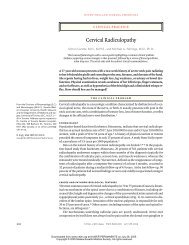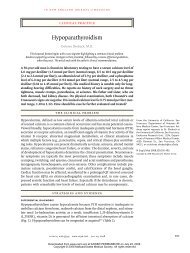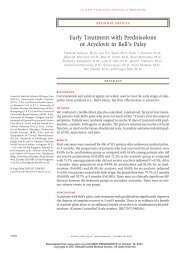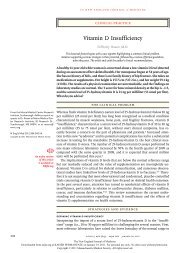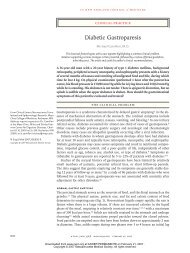Hypertension in Pregnancy 2011.pdf
Hypertension in Pregnancy 2011.pdf
Hypertension in Pregnancy 2011.pdf
You also want an ePaper? Increase the reach of your titles
YUMPU automatically turns print PDFs into web optimized ePapers that Google loves.
T h e n e w e ngl a nd j o u r na l o f m e dic i n e<br />
Table 2. Guidel<strong>in</strong>es for Antihypertensive Treatment for Chronic <strong>Hypertension</strong> <strong>in</strong> <strong>Pregnancy</strong>.*<br />
Variable ACOG 18 (2001) NHBPEP Work<strong>in</strong>g Group 17 (2000) JNC 7 14 (2003) Canadian 41 (2008) Australasian 29 (2000)<br />
Evaluation before<br />
pregnancy<br />
Blood-pressure levels<br />
for treatment and<br />
goals<br />
Consider test<strong>in</strong>g of creat<strong>in</strong><strong>in</strong>e,<br />
blood urea nitrogen, 24-<br />
hr ur<strong>in</strong>e prote<strong>in</strong> and creat<strong>in</strong><strong>in</strong>e<br />
clearance, uric<br />
acid, along with electrocardiography,<br />
echocardiography,<br />
ophthalmologic<br />
exam<strong>in</strong>ation, and<br />
renal ultrasonography<br />
Evaluate for secondary causes<br />
<strong>in</strong> presence of suggestive<br />
symptoms or signs<br />
Treat if blood pressure is<br />
³≥180 mm Hg systolic or<br />
³≥110 mm Hg diastolic<br />
for maternal benefit<br />
Mild hypertension (140–179<br />
mm Hg systolic or 90–<br />
109 mm Hg diastolic)<br />
usually does not require<br />
pharmacologic treatment<br />
If medication is tapered, restart<br />
if >150–160 mm Hg<br />
systolic or >100–110<br />
mm Hg diastolic<br />
Medications First-l<strong>in</strong>e, methyldopa or<br />
labetalol<br />
Avoid ACE <strong>in</strong>hibitors <strong>in</strong> second<br />
and third trimesters†<br />
In women with a history of<br />
hypertension for several<br />
years, evaluate for targetorgan<br />
damage, <strong>in</strong>clud<strong>in</strong>g<br />
left ventricular hypertrophy,<br />
ret<strong>in</strong>opathy, and<br />
renal disease<br />
Consider taper<strong>in</strong>g antihypertensive<br />
medications and<br />
re<strong>in</strong>stitute or <strong>in</strong>crease<br />
dose if blood pressure is<br />
>150–160 mm Hg systolic<br />
or >100–110 mm Hg<br />
diastolic<br />
Methyldopa is preferred by<br />
many physicians, with labetalol<br />
an alternative<br />
Avoid ACE <strong>in</strong>hibitors†<br />
Assess for secondary causes<br />
and presence of targetorgan<br />
damage<br />
Cont<strong>in</strong>ue medication if there<br />
is target-organ damage or<br />
a previous requirement<br />
for multiple antihypertensive<br />
agents for bloodpressure<br />
control<br />
If medication is stopped, re<strong>in</strong>stitute<br />
if blood pressure<br />
is 150–160 mm Hg systolic<br />
or 100–110 mm Hg<br />
diastolic<br />
Methyldopa is preferred by<br />
many physicians, with labetalol<br />
<strong>in</strong>creas<strong>in</strong>gly preferred<br />
because of reduced<br />
side effects<br />
Avoid ACE <strong>in</strong>hibitors and<br />
ARBs<br />
Not specified Investigate potential causes<br />
of secondary hypertension<br />
If ur<strong>in</strong>alysis is positive for<br />
prote<strong>in</strong>, then 24-hr ur<strong>in</strong>e<br />
prote<strong>in</strong> analysis or measurement<br />
of spot ur<strong>in</strong>e<br />
prote<strong>in</strong>-to-creat<strong>in</strong><strong>in</strong>e ratio;<br />
test<strong>in</strong>g of blood glucose,<br />
electrolytes, and<br />
renal function (e.g., serum<br />
creat<strong>in</strong><strong>in</strong>e and uric<br />
acid)<br />
Treat if blood pressure is<br />
>169 mm Hg systolic or<br />
>109 mm Hg diastolic to<br />
lower risk of maternal cerebral<br />
hemorrhage or if<br />
>139 mm Hg systolic or<br />
>89 mm Hg diastolic <strong>in</strong><br />
patients with target-organ<br />
damage or other underly<strong>in</strong>g<br />
condition<br />
First-l<strong>in</strong>e, methyldopa; second-l<strong>in</strong>e,<br />
labetalol, p<strong>in</strong>dolol,<br />
oxprenolol, or nifedip<strong>in</strong>e;<br />
third-l<strong>in</strong>e, clonid<strong>in</strong>e<br />
Avoid ACE <strong>in</strong>hibitors and<br />
ARBs<br />
Treat if blood pressure is<br />
>170 mm Hg systolic or<br />
>110 mm Hg diastolic<br />
Suggested target is 110–140<br />
mm Hg systolic and 80–<br />
90 mm Hg diastolic if<br />
there are no undue side<br />
effects<br />
Priority not <strong>in</strong>dicated, but acceptable<br />
agents listed<br />
<strong>in</strong>clude methyldopa, labetalol,<br />
clonid<strong>in</strong>e, hydralaz<strong>in</strong>e,<br />
atenolol, and<br />
oxprenolol<br />
Avoid ACE <strong>in</strong>hibitors†<br />
* ACE denotes angiotens<strong>in</strong>-convert<strong>in</strong>g enzyme, ACOG American College of Obstetricians and Gynecologists, ARB angiotens<strong>in</strong>-receptor blocker, JNC 7 Jo<strong>in</strong>t National Committee on<br />
Prevention, Detection, Evaluation, and Treatment of High Blood Pressure 7, and NHBPEP National High Blood Pressure Education Program.<br />
† These guidel<strong>in</strong>es were issued before the widespread recognition of the adverse effects of ARBs on the fetus.<br />
444<br />
n engl j med 365;5 nejm.org august 4, 2011<br />
The New England Journal of Medic<strong>in</strong>e<br />
Downloaded from nejm.org at KAISER PERMANENTE on August 4, 2011. For personal use only. No other uses without permission.<br />
Copyright © 2011 Massachusetts Medical Society. All rights reserved.






